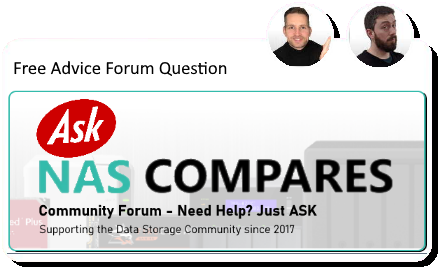Posts: 1,089
Threads: 1,090
Joined: Feb 2020
Reputation:
2
Hi,
I wanna get a NAS and I want to be able to use it for video editing. The Main question I have is which NAS would be the main recommendation for my use case.
I have done some researching myself and I am personally looking at the rs1221+ and the UNAS Pro.
I only really intend to use the NAS for storage, which is why the latter is an option IMO and quiet good budget wise. The main Concern I have is the weaker CPU in the UNAS Pro not being sufficient to saturate the full 10GB sfp+ connection
Posts: 5,263
Threads: 2
Joined: Jun 2022
Reputation:
35
Thanks for reaching out! It’s great that you’ve already started researching. Based on your use case—video editing for a small videography business—here’s my advice tailored to your budget, capacity requirements (50TB+), and performance needs.
Key Considerations for Your Use Case:
10GbE Saturation: Real-time video editing over a 10GbE SFP+ connection requires a NAS with a sufficiently powerful CPU, ample RAM, and SSD caching to avoid bottlenecks.
Capacity and Expansion: Starting with 50TB+ and leaving room for future scalability is essential.
Budget: $3000 is sufficient to build a robust solution with enterprise-grade features.
Recommendations:
1. Synology RS1221+ (or RS1221RP+ for redundant PSU):
Pros:
Solid performance with the AMD Ryzen V1500B (4-core CPU).
Native support for 10GbE with an optional NIC (e.g., Synology E10G18-T1).
Scalable with the Synology RX418 expansion unit for future capacity.
DSM software is highly reliable and user-friendly, perfect for managing storage workflows.
Cons:
Limited raw power compared to other options for heavy editing tasks directly from the NAS.
Best suited for proxy-based workflows or caching mechanisms.
2. QNAP TVS-h1288X:
Pros:
Intel Xeon W-1250 CPU (6 cores, 12 threads)—ideal for high-performance workloads, including video editing.
Built-in dual 10GbE ports (SFP+ and RJ45) for maximum flexibility.
ZFS file system support for data integrity and advanced caching options.
8 HDD bays + 2 NVMe SSD slots for caching or tiered storage.
Easily expandable with QNAP expansion units (e.g., TL-D800S).
Cons:
Higher upfront cost, but worth it for demanding tasks.
3. UNAS Pro:
Pros:
Budget-friendly and customizable with your choice of CPU and storage configuration.
Potentially cheaper initial setup for a storage-only NAS.
Cons:
Weaker CPU (depending on the specific model), which might struggle to saturate 10GbE during concurrent workflows.
Requires more manual configuration and lacks the polished software experience of Synology or QNAP.
My Recommendation:
If your primary focus is real-time video editing, go for the QNAP TVS-h1288X. It’s more expensive than the RS1221+, but the Xeon CPU ensures you can fully utilize the 10GbE connection for editing large files without bottlenecks.
If you’re primarily using the NAS for storage and backup, with occasional editing, the Synology RS1221+ is a great choice and more cost-effective.
Suggested Storage Configuration:
Start with 8 x 10TB or 12TB drives (e.g., Seagate IronWolf Pro or WD Red Pro) in RAID 6 for redundancy (total usable capacity ~60-70TB).
Add 2 x NVMe SSDs for read/write caching (e.g., Samsung 970 Evo Plus).
Networking Setup:
Connect your Mac and PC to the NAS via a 10GbE SFP+ switch (e.g., Netgear XS505M).
Use a Thunderbolt-to-10GbE adapter for the Mac (e.g., QNAP QNA-T310G1SFP).





